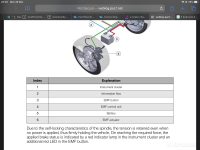Smartbear said:
Pbondar said:
The e brake needs to be off.
Otherwise the pads will be clamped hard onto the discs.
The e brake runs continuously in the background if it’s applied maintaining clamp pressures

Hi Pete, i don’t believe the ebrake runs continuously - it relies on a self locking mechanism to maintain brake pressure when applied but no power is being fed. If the car is detected moving the car applies power to the ebrake until movement has stopped

41E77EB3-BFDE-4253-A3F2-A93D3FDB9A4A.png
Rob
Rob,
As far as I can see looking at TIs we are both correct...
The DSC system monitors roll away conditions to re-apply the EFB and also temperature monitoring takes place to ensure adequate clamp pressure as the discs cool down.
As an aside my Rover 220 Turbo Coupe had mechanical parking brake sitting on rear discs...at my parent’s home, their drive was very steep, parked there, put the handbrake on, 49 minutes later car alarm going off, car had rolled down the driveway and had hit the house..
This refers
Temperature monitoring
Temperature monitoring ensures that the braking force reduction that occurs when hot brake discs cool is compensated for. Temperature monitoring is activated if the temperature exceeds a defined value when the parking brake status is changed from released to engaged.
The temperature of the brake discs is individually calculated for each wheel by the DSC control unit and transmitted to the parking brake control unit. During a state change, the higher of the two temperature is used for temperature monitoring. The corresponding temperature ranges with the associated retensioning times are stored in a characteristic map.
Depending on the temperature during the state change, the corresponding retensioning times are activated from the characteristic map. When the first retensioning time is reached, retensioning occurs for the first time. After expiry of the second retensioning time, retensioning occurs again; this is repeated once more after a third retensioning time. In the characteristic map, the value 0 can be stored for one or more retensioning times. In this case, the associated retensioning processes are omitted. The function ends when the last retensioning process is finished.
Roll monitoring
The roll monitoring function prevents the vehicle from rolling with the parking brake engaged. Roll monitoring is always activated when the parking brake status changes from released to engaged and ends after a defined time elapses after this status change.
The input parameter used to detect rolling is a signal from the DSC. When roll monitoring is active, the EMF actuators are retensioned as soon as this signal indicates that the vehicle is beginning to roll. The EMF actuators are supplied with full current for 100 ms to increase their tension. Then the system waits for 400 ms. If the vehicle begins rolling again, the retensioning procedure is repeated (a maximum of three times). If, after the third retensioning, the monitor still detects the vehicle as rolling, the function ends with a fault entry in the fault memory.
